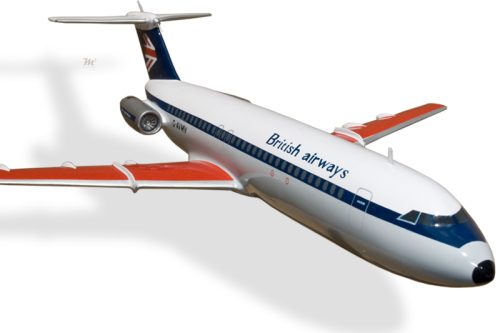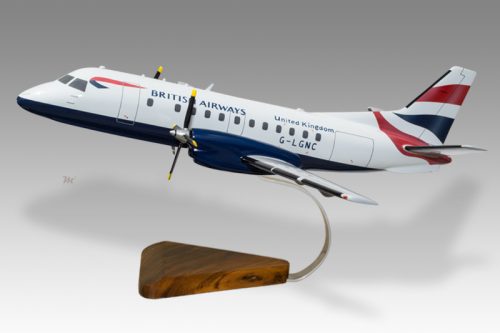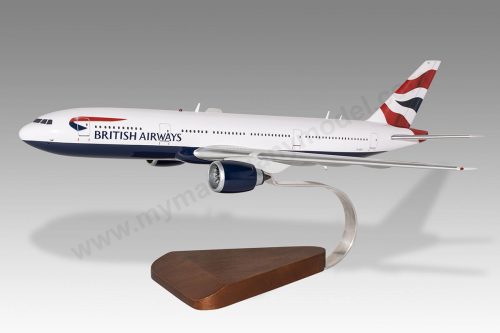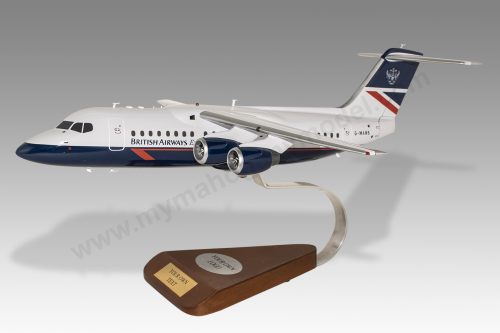BAC 111 British Airways
Production Time 9 to 10 weeks
Shipment is by FedEx, UPS or DHL International Express Courier with a normal door-to-door delivery time worldwide of within 2-3 business days after dispatch. Due to the current volatility of world fuel prices, the amount mentioned here is our best estimate for DHL and UPS and may be subject to change at the time of shipping.

Model Description: BAC 111 British Airways Wood Replica Scale Custom Model Aircraft
Manufacturer: British Aircraft Corporation (BAC)
Product Statistics
Length: 17 Inches (43.2 Centimeters)Wingspan: 16.3 Inches (41.4 Centimeters)
Height: 4.4 Inches (11.2 Centimeters)
Scale: 1:65
$239.50
Production Time 9 to 10 weeks
-
United States dollar ($)
-
Pound sterling (£)
-
Euro (€)
-
Australian dollar ($)
-
Canadian dollar ($)
-
Singapore dollar ($)
-
Swiss franc (CHF)
-
Japanese yen (¥)
-
Danish krone (kr.)
-
Hong Kong dollar ($)
-
Norwegian krone (kr)
-
Swedish krona (kr)
General Product Description
Our MyMahoganyModel BAC 111 British Airways exhibits unique, unrivaled quality and detailed design to come as close as possible to the accuracy of the actual plane. It comes as standard with a robust, durable base or stand which is available in a variety of different finishes designed to match your own personal requirements including solid wood, wood with polished metal supports or adjustable wood wall mount and will be ready within about 9-10 weeks from placement of order.
The BAC 111 British Airways is made of the finest kiln dried renewable mahogany wood (commonly known as Lauan or Meranti) which has undergone many stages of carving and meticulous and careful sanding giving the beautiful finished museum quality masterpiece. Many collectors and model connoisseurs demonstrate their preference for genuine handmade and hand painted mahogany wood models rather than plastic or die cast (diecast) alternatives due to the overall look and totally different feel of the item - we trust you will find the same. We can, however, if required produce the same model in Solid Cast Resin so just click and contact us us for further information. Our craftsmen and gifted artisans ensure that our finely handcrafted model airplanes match the precise blueprint details of the original aircraft. The paint scheme, markings and parts are closely matched, reflecting the original aircraft. This stylish top-quality desktop replica model will surely enthrall anyone who receives this as a gift and for sure one of the most appropriate and desirably collectable gifts for any aviation enthusiast and avid aircraft collector whilst also displaying a perfect resemblance to the actual aircraft.
If you require we can also make the BAC 111 British Airways in any other airline, private livery or colour scheme you require and if necessary in a different size or scale. Just click here to contact us with a description or photographs of what you require, and we will let you have a quotation for the necessary customization by return email. We can also make bespoke scale replicas of any other private / civil commercial airliner or airliners, helicopter, glider, gliders with engines, military jet, warplane jets, propeller warplanes, biplane, triplane, tail fin, spacecraft, rocket or NASA model you require in any airline, military or civilian livery or colors. We also produce model airships, blimp, dirigible, blimps, boat and ship collectibles. Wall plaque or seal for military, government or private customers. Again, by clicking here to contact us just let us know exactly what you need.
The BAC 1-11: British Caledonian’s Workhorse
The British Aircraft Corporation 1-11, commonly known as the BAC 1-11, is an iconic piece of aviation history, especially for British Caledonian Airways. This short-haul jet airliner was pivotal in shaping regional air travel during its prime. Its significance to British Caledonian, a major operator of the type, can’t be understated. This article explores the BAC 1-11’s important features, its role with British Caledonian, and its legacy in the aviation industry.
Design and Development:
The BAC 1-11 was developed in the 1960s as the UK’s answer to the Boeing 727, aiming to capture the burgeoning market for short- to medium-haul jet airliners. Its design was pioneering for its time, featuring a T-tail and powered by two rear-mounted Rolls-Royce Spey turbofan engines. This configuration provided significant advantages in terms of performance and maintenance, making it an attractive option for airlines worldwide.
Operational Excellence with British Caledonian:
British Caledonian Airways, formed in November 1970 through the merger of British United Airways and Caledonian Airways, became one of the largest operators of the BAC 1-11 One Eleven. The airline utilized the aircraft primarily for its European and domestic routes, capitalizing on its efficiency and performance to serve its business and leisure passengers.
The BAC 1-11’s ability to operate out of shorter runways made it particularly valuable to British Caledonian, allowing the airline to fly from airports closer to city centers and thus providing greater convenience for its passengers. This capability helped British Caledonian establish a strong market presence, especially on routes where larger jets could not operate.
Features that Made a Difference:
- Efficiency: The BAC 1-11 was known for its fuel efficiency and low operating costs, which was crucial for airlines during the oil crises of the 1970s.
- Performance: Its powerful Rolls-Royce Spey engines allowed for quick climb rates and a cruising speed comparable to larger jetliners, making it ideal for short to medium-haul flights.
- Capacity: Depending on the variant, the BAC 1-11 could seat between 79 and 119 passengers, offering flexibility for airlines to adjust capacity according to demand.
- Autoland Capability: Later versions of the BAC 1-11 were equipped with autoland technology, enhancing safety and reliability in poor visibility conditions.
Legacy and Demise:
The BAC 1-11 served British Caledonian and other airlines reliably for several decades. However, as aviation technology advanced and noise regulations became stricter, the BAC 1-11’s days were numbered. The introduction of newer, more efficient, and quieter aircraft led to the gradual phase-out of the BAC 1-11 from commercial service.
Despite its eventual retirement, the BAC 1-11 remains a fondly remembered workhorse of the skies. Its role with British Caledonian Airways, in particular, exemplifies its importance in the development of regional air travel in the UK and beyond.
| Weight | 6 kg |
|---|---|
| Dimensions | 17 × 16.3 × 4.4 in |
Be the first to review “BAC 111 British Airways” Cancel reply
Similar Models
Helicopters
Private & Civilian
Private & Civilian
Private & Civilian
Private & Civilian
Private & Civilian
Lockheed L-1011-385 TriStar British Airways Livery Version 2 Model
Private & Civilian
Hawker Siddeley Trident-1E Northeast Airlines British Airways Model
Private & Civilian
Private & Civilian
Private & Civilian
Private & Civilian
Private & Civilian
Concorde British Airways G-BOAG (Cut Away Version) Solid Cast Resin Model
Private & Civilian
Private & Civilian
Private & Civilian
Private & Civilian
Private & Civilian
Private & Civilian
Private & Civilian
Private & Civilian
Private & Civilian
Private & Civilian
Private & Civilian
Private & Civilian
Private & Civilian
Private & Civilian
Private & Civilian
Private & Civilian
Private & Civilian
Private & Civilian
Private & Civilian
Private & Civilian











































Reviews
There are no reviews yet.